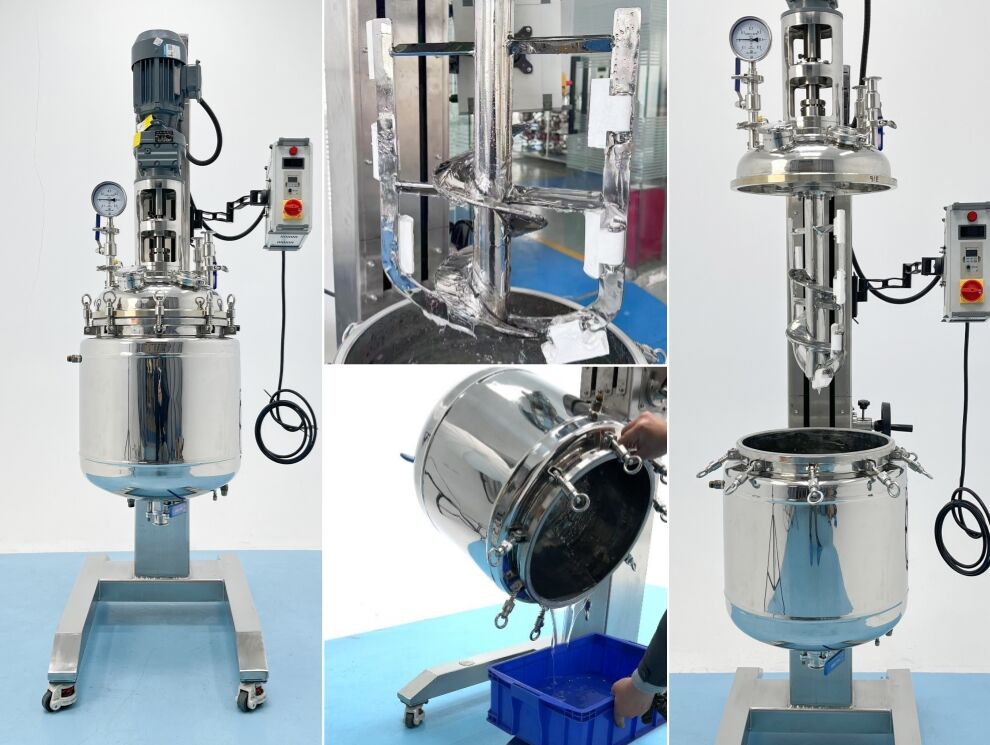Robust Construction for High-Pressure and Corrosive Environments
Stainless steel's structural superiority makes it the material of choice for jacketed stainless steel reactors operating in harsh industrial conditions. Its combination of mechanical strength and corrosion resistance ensures reliable performance where glass-lined or alternative materials often fail.
Why Stainless Steel Outperforms Glass in Pressure and Corrosion Resistance
Glass reactors exhibit 72% lower tensile strength than 316L stainless steel, limiting their use in high-pressure applications exceeding 10 bar. According to recent research (ScienceDirect 2025), advanced stainless steel alloys reduce annual corrosion rates by up to 85% in chloride-rich environments compared to glass. This resilience is due to three key properties:
- Formation of a protective chromium oxide layer (3–5 nm thick)
- Superior thermal shock resistance (withstands ΔT 200°C)
- 40% higher fracture toughness at pressures above 25 bar
These characteristics make stainless steel inherently more reliable under extreme thermal and mechanical stress.
Material Integrity Considerations for Aggressive Chemical Processing
In highly acidic or alkaline environments (pH 12), material integrity is critical. Duplex stainless steels maintain 95% surface integrity after 5,000 hours in 15% HCl solutions—three times better than standard grades. Engineers prioritize the following when selecting materials:
- Pitting Resistance Equivalent Number (PREN 40)
- Resistance to stress corrosion cracking (thresholds above 60°C in chloride environments)
- Stable passivation across pH 2–11 ranges
This performance enables uninterrupted operation in API and intermediate synthesis, preserving structural uniformity even under cyclic loading.
Long-Term Cost Efficiency Through Durability and Low Maintenance
Stainless steel jacketed reactors deliver excellent value over their lifespan thanks to durable construction and low maintenance needs. These units can withstand both thermal fatigue and mechanical stress, making them capable of running non-stop for many years without significant issues. According to research from the Materials Performance Institute in 2023, reactors made with corrosion-resistant alloys needed about 63 percent fewer unexpected repairs during a 15-year span when compared against standard reactor designs. This kind of reliability translates directly into cost savings for plant operators who want to minimize downtime and maximize productivity.
Extending Reactor Lifespan in Continuous Industrial Operation
A dual wall jacketed design keeps the inner part of the reactor protected against harsh chemicals and temperature extremes, which helps slow down wear and tear over time. The advanced welding techniques combined with stress relief during manufacturing stop those tiny cracks from forming. Plus, when heat is distributed evenly throughout the system, it cuts down on the kind of damage caused by repeated heating and cooling cycles. Put all this together and what happens? These reactors can still hold about 90% of their initial pressure containment strength even after running nonstop for around 50,000 hours in typical pharmaceutical batch operations.
Reducing Total Cost of Ownership With Corrosion-Resistant Construction
The natural resistance of stainless steel to corrosion means there's no need for those pesky protective liners or constant recoating that plague carbon steel systems. And this has some serious benefits beyond just looking clean. Contamination becomes less of a worry, plus companies save money on maintenance expenses somewhere around $18 to $42 for every square foot according to Chemical Processing Equipment Association data from 2024. When it comes to cleaning processes, stainless steel plays nice with automated CIP systems which cuts down downtime significantly. We're talking about reducing wait times between production runs by roughly 35 to 40 percent compared with old-fashioned manual cleaning approaches that take so much time and labor.
Seamless Scalability and Integration in Modern Production Facilities
Scaling from Pilot to Full Production: Design Consistency Across Volumes
Jacketed stainless steel reactors streamline scale-up by maintaining consistent geometry, instrumentation, and thermal profiles from lab-scale to full production. This uniformity avoids costly revalidation and shortens development timelines. Integrated engineering approaches confirm this strategy can reduce project lead times by 30% in multi-phase pharmaceutical manufacturing.
Integrating Jacketed Stainless Steel Reactors Into Automated Process Lines
Standardized flange connections and digital control interfaces allow seamless integration into automated workflows. Real-time monitoring systems synchronize reactor operations with upstream and downstream equipment, minimizing manual intervention while maintaining ±0.5°C thermal precision during continuous runs.
Balancing Standardization and Flexibility in Multi-Product Manufacturing
Modular reactor setups with interchangeable agitators and adjustable jacket configurations support rapid changeovers. By using fixed frames with swappable process modules, facilities achieve up to 85% equipment utilization—enabling efficient production of both small-batch specialty chemicals and large-volume APIs on shared infrastructure.
FAQ
What makes stainless steel better than glass in reactors?
Stainless steel has superior tensile strength, corrosion resistance, and durability compared to glass, making it ideal for high-pressure and corrosive environments.
Why is stainless steel more cost-efficient in reactors?
It requires less maintenance and repair over time due to its robustness and corrosion resistance, resulting in lower long-term operation costs.
How does stainless steel enhance scalability in production?
Its consistent design across volumes simplifies scale-up, reducing project lead times and revalidation costs.

